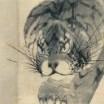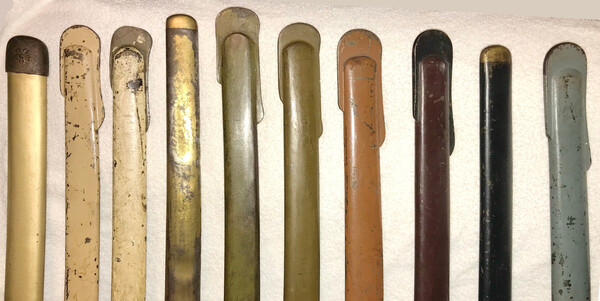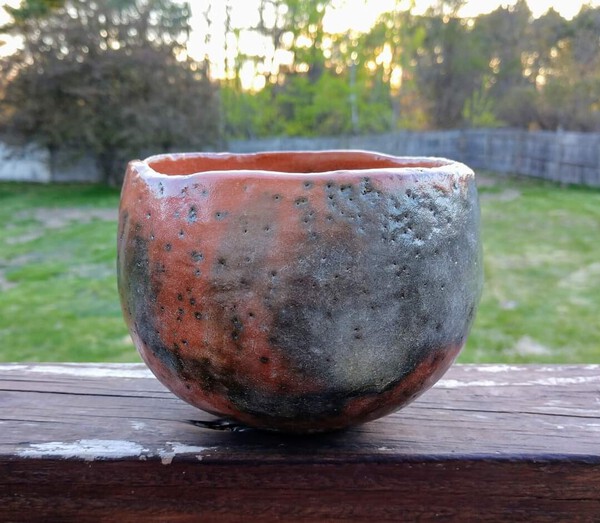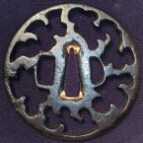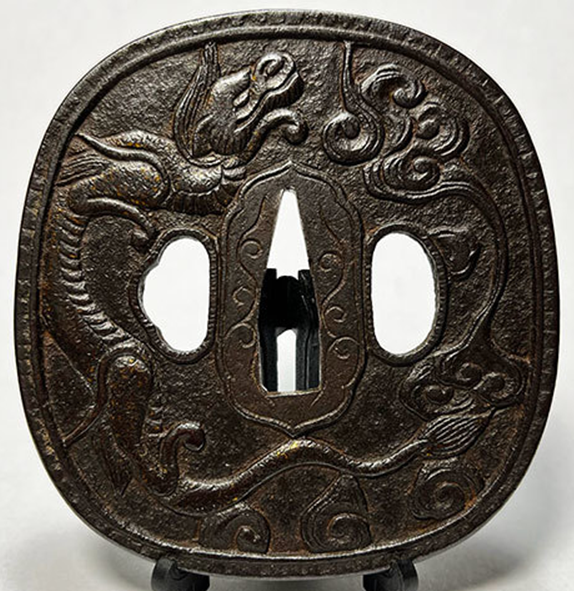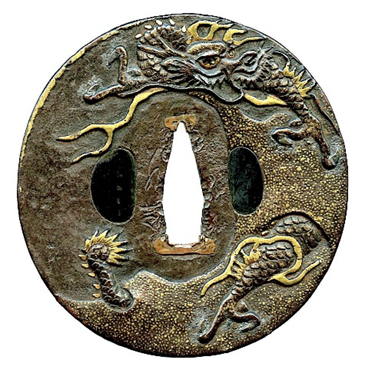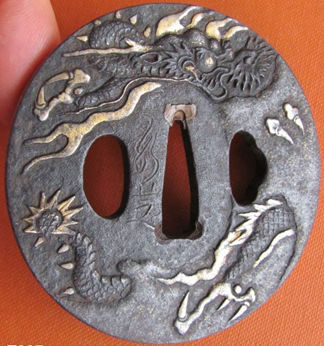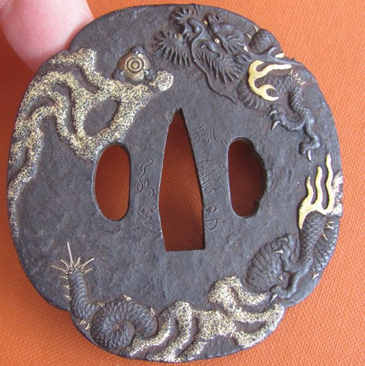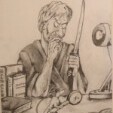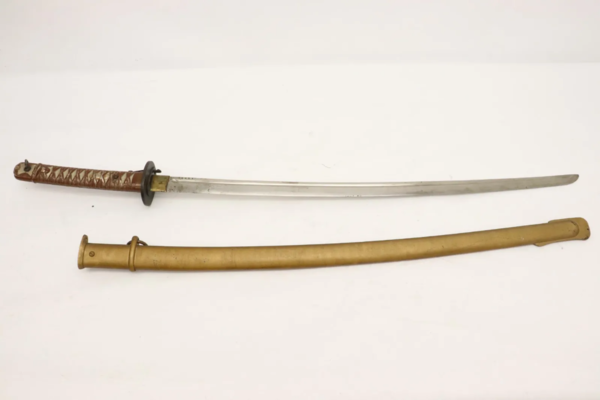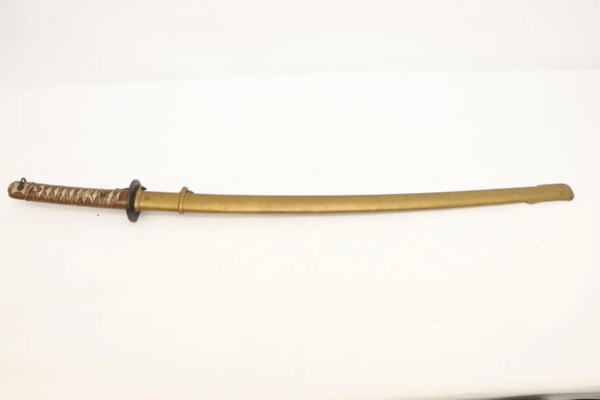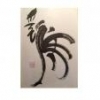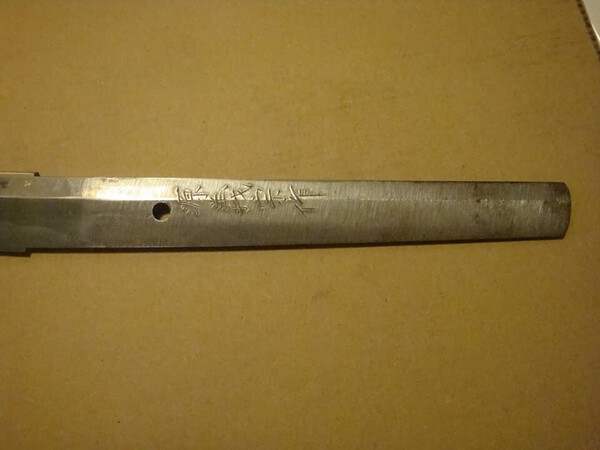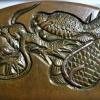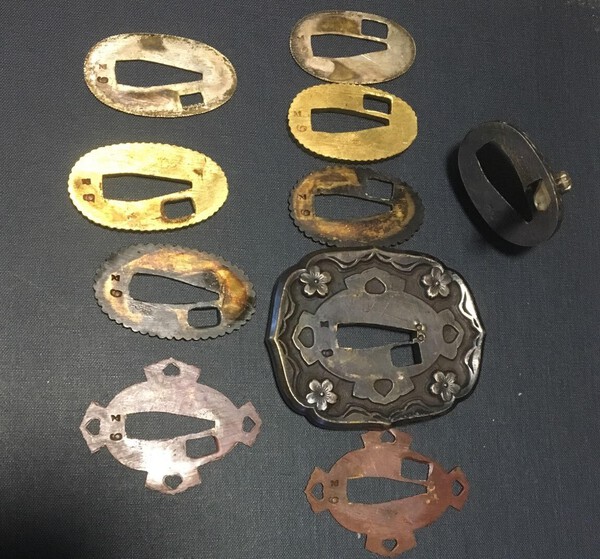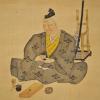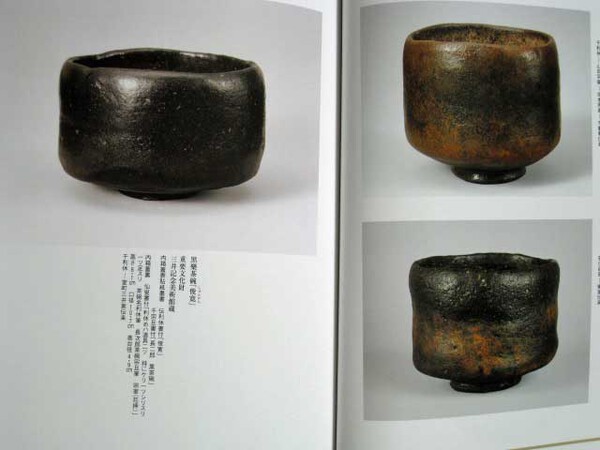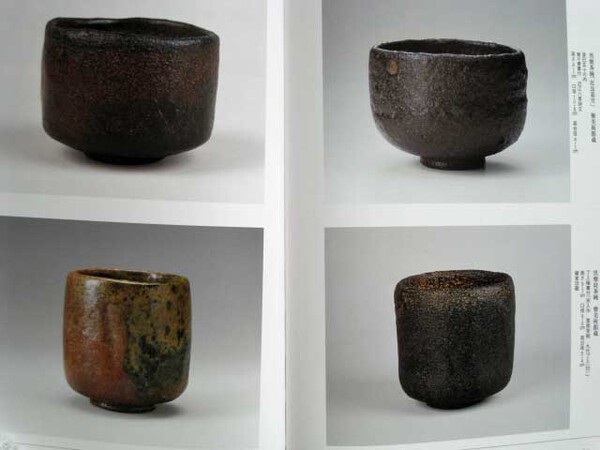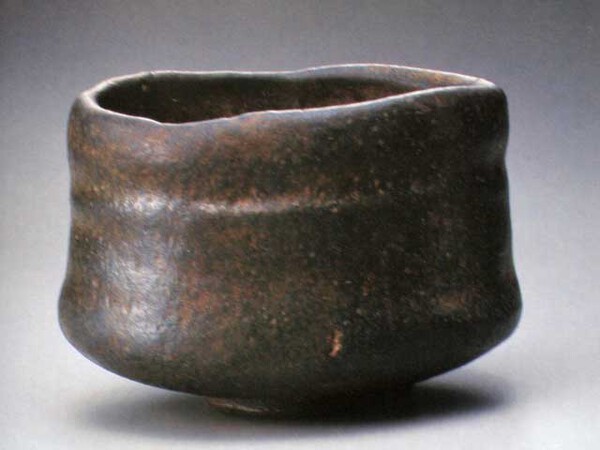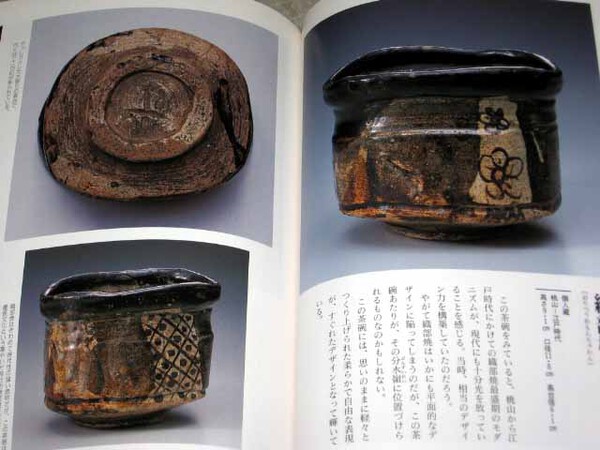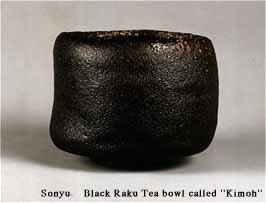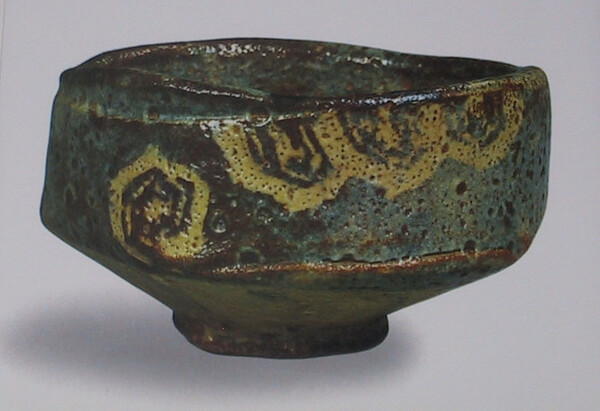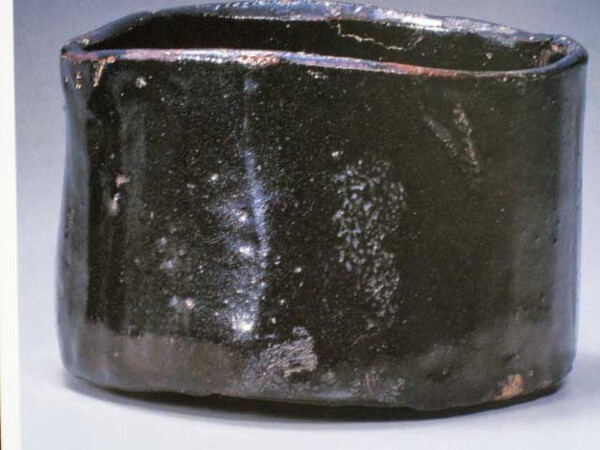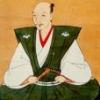Leaderboard
Popular Content
Showing content with the highest reputation on 01/07/2022 in all areas
-
HI Khalid, I have a few thoughts on this below and a great article from Guido Schiller.11 points
-
If we consider the 1943 IJA camouflage document for static and mobile weapons (which also includes Small Arms) as posted and explained by Nick Komiya on the Warrelics forum, i think you can see that of the 4 basic colours mentioned, the 'Hay' (Dead Grass 枯草色 Karekusa-Iro), is the closest to resembling the 'gold' that we are talking about here. Perhaps it was the only available paint, close enough to the dried grass/hay, and was therefore used instead. This colour was used in the grassy plains environment especially during the summer months. The top 4 colours were used prior to 1943, the black (not shown) was now no longer able to be used as an outline colour as it had been in Manchuria proir to the 1943 manual update. White (also not shown) got mentioned for the winter/snow environment, particularly with relation to reflective factors. Here you can see several different colours used on the type 95 scabbards, and sometimes even on the handles. Note the black outline used on the 3rd last sword. The RS scabbard was included as an example of colour used only. The 'Grey' at the end was only used in Naval colour schemes. Bruce, the winter camo swords you posted in post#3, are all mine except for the second one down.7 points
-
古藤島 – Ko-Fujishima 但大磨上無銘也 – However, it is Osuriage and mumei. 南北朝期傑之一 – One of good works in Nanboku-cho period. 刃長貳尺五寸二(?)分有之 – Blade length: 2-shaku, 5-sun, 2(?)-bu 昭和庚戌年初冬吉日 – Showa kanoe-inu year (=1970), a luckey day in early winter 寒山誌 – Kanzan wrote.7 points
-
Ceramics seem to be selling better than tsuba lately, so here's another one for our members to snatch up. On offer today is a truly wonderful teabowl - Raku in general is flooded with mediocre pieces, and Aka-Raku in my opinion more so than its black counterparts. Many are a mess with off forms and muddled glazing that lacks the vision to create anything resembling a landscape. None of that here. This chawan measures 13.2 x 9.3cm, a full bloom size that honors its shape and the origins of the style, of whick Koetsu is the undisputed champion. The hand built form instantly melts into the hands and is one of my favorites to drink tea from. There's good reason for the saying "Ichi Raku", and it's an equal delight throughout the preparation stage. The low fired body characteristic of Raku produces a soft tone against the chasen while whisking, like a distant breeze in the pines. Of course it looks just as good on a shelf if that's your thing. The carburized areas have the depth of a galaxy and glow even in low light. The accent on the foot ring presents in a stunning, Enso like fashion on the interior which is a sublime touch. Condition is nearly perfect for its age, with only a couple small, shallow chips to note on the inside edge. Given Raku's fragile nature, these could have been there since the bowl was fired and they do not detract from the visual beauty or usability of the piece. Quite the opposite in my opinion. Its original signed box is also included and is in equally great shape. Price is $250 shipped Worldwide. And like the other ceramics I've listed here, I challenge you to find a comparable piece for anywhere close to that. Please let me know if you have any questions or need additional pics. Thanks for looking! 👺🙏🍵5 points
-
Hi everyone, I woke-up this morning and decided to take a few pictures of my first Japanese sword restoration project. This sword is a wakazashi of some sort that was shipped back to the United States from somewhere in the pacific during WWII. Purchased from a local auction house for a nominal sum of $500 the blade was in a tired condition, and the fittings were dirty as it was stored in a wooden box with hay padding. I decided to roll the dice on the restoration of my 1st Japanese sword simply because I liked the war mounts and the hamon. It came out decent I'd say. Moses Becerra who is based out of Florida did the restoration work. It was not cheap to do. After about a years wait and 10 days of polishing this is what I got back. Let us know what you think. Best, Khalid3 points
-
Khalid wrote: > I did get a earful from a few local collectors on having a unsigned blade restored. Congratulations on following your own path. It is the best way in the long run to learn about Nihonto - i.e., make your own mistakes. It took me many years of 'doing it on my own' and I've written about it before. Here are some sayings I give credence to: "To thine own self be true", "The quality is remembered long after the price is forgotten". And my own "Never shell out money on a Japanese sword unless you can afford to lose it totally". You do learn quickly this way!!! Khalid, I have been collecting for 55 years on a shoe-string budget and am never going to get back all the money I've put into it - BUT - the journey has been priceless!! BaZZa. Oh, and some unsigned swords may turn out to be o-suriage mumei blades from the Kamakura or Nambokuchou period - I have two of them!!3 points
-
I was amazed to see 2-3 of these identical fakes show up in the group I manage within the same week. Someone is running a Yoshimune factory...3 points
-
I am not a fan nor an expert of RAKU, but this is the most beautiful AKA-RAKU CHAWAN I have seen in a looooong while.3 points
-
I have never regretted joining the To-Ken Society - in fact one of my best decisions ever, together with following this portal/community for well over 16-17 years. The NMB provided theoretical knowledge while the To-Ken meetings enabled me to see swords and koshirae first hand and hear more experienced people describe these items while teaching us. Of course, once one builds an own network of contacts, then it becomes easier to navigate the field solo. But still, the social and educational elements are valuable. In informal and interpersonal meetings, one can learn and share a lot more than publicly..... People sometimes focus too much on price. Price is an important element of a purchase but so is the quality of the item, the guarantees, the deferred purchasing methods that some offer, the trustworthiness, the investment in a relationship with someone who might offer you items that will never be published officially on a website et cetera. Also, my main piece of advice is to defer a purchase until you can make your own judgment rather than rely on judgements by others. If it takes years, so be it. It might be better than burn money, burn bridges/relationships, get disappointed, acquire something that in a year you will not like anymore as you have changed your mind or did not know what you were buying in the first place.3 points
-
Hi Khalid, Pretty sure this is a broken sword and you're looking at the lower half. This is close to being worthless in an informed market. Grey2 points
-
I agree! A very clear and helpful progress through 5 basic needs the Nihonto collector must face. Thank You Ray.2 points
-
Good morning Gentlemen, Please look carefully at the support for the right foot. Looks like a lead based solder.2 points
-
What an awesome video. Not only due to the shoutout (thanks for that Ray) but because the advise is concise on the money. And if I may say Ray, you have such a calming and clear narrating voice that I could listen to it for days. A great service to the Nihonto community.2 points
-
At first glance I can see Namboku-Cho period, the blade length, and Kanzan's dated signature.2 points
-
As of 1937, Shigemitsu live in Fukuoka City 福岡市, Fukuoka Prefecture 福岡県. His full name is Suetsugu Shigemitsu 末次・繁光 and he and his 7 apprentices could turn out five blades per month. The use of Tsukushi 筑紫 above his signature can mean one of two things. 筑紫国 Tsukushi Province was an ancient province now located within Fukuoka Prefecture 福岡県. Tsukushi-no-shima 筑紫島 "Island of Tsukushi" is another name used in the past for Kyūshū 九州. I am inclined to think Tsukushi 筑紫 in this context is referring to the old province and not the island. Does anyone have any thoughts that differ from this interpretation? A link to one of his blades made in August 1945. 福岡住末次繁光作 昭和二十年八月日 @mecox Another one for the naval swords monograph. Looks like number 264? 博多刀匠 末次繁光2 points
-
That's a such a multi-faceted question, Paz, that it is hard to know where to begin. A Mon or Kamon shows close or distant allegiance/affiliation/association with a particular clan or family, used with permission, (but in later centuries increasingly without permission from anyone). It is rare that a Mon alone can be used to pin down anything historically, but in some cases it is clear from the rest of the circumstantial evidence that it can be the final authenticating piece within an overall package. On average I find that the presence of a finely executed Mon adds a touch of cachet, a dash of romance, (I hate to use the debased word 'class'), like the cherry on a cake. PS Just noticed another mini question in there. Old blades are very rarely found in their original Koshirae. The number of mekugi holes in the nakago will give you an indication of how often the koshirae was changed. If it's a good blade that has been passed down between or within illustrious families, it could be that in a time of opulence the owner has decided to fit it with a splendid-looking koshirae, studded with family crests (Kamon). Generally such a blade and package will fetch top dollar today.2 points
-
Just for comparison, Here are some other Nanban dragons that are on solid plates (rather than on their more commonly seen tsuba that are highly pierced): Here are some Jakushi dragons that have a pretty consistent look to them: always heavy on the chin hairs, and have long tendrils from the snout, and antlerlike horns. The overlay always covers an entire component in the design, like a whole cloud, or whole portion of the design in the background, or the horns or claws on the dragon: I had a look through the 24 images of Jakushi dragon tsuba in my files, and they all show these characteristics.2 points
-
Mark is right you don't need to belong to a society or club to import a sword at present. However proof of membership of a society or martial arts club can be used as proof of a legitimate interest and reason to want to want one2 points
-
The first appears to be signed Kii no kuni Yasutsuna. https://nihontoclub.com/smiths/YAS9971 point
-
Daimyo families had primary and secondary mon - sometimes as many as four - truth is that unless the particular mon is singularly unique to a single family you cannot ascribe any mon to any person, family or line. Should you find an item of quality that includes two or more mon then the probabilities are much higher but it is still just supposition without other evidence. Swords had an incredible currency over the years - some families patronized their local swordsmiths and boasted many blades by their hometown artist in their collections - many families had swords from all over and almost none from local smiths, even when they were directly employed by that family... -t1 point
-
I will take Ray one step further and provide a link to his blog post that the video is based upon. 5 Guidelines for the Beginning Collector of Japanese Swords And since I am looking at his website, I will provide the link to the articles written by the late Jim Kurrasch. Jim Kurrasch articles As a former editor and publisher once told me, it is better to beg for forgiveness than to ask for permission!1 point
-
1 point
-
Hi Khalid, The mei is Tango no Kami Fujiwara Kanemichi and on the reverse Kiku Ichi. It is a real Japanese sword but that doesn't mean the signature isn't a forgery; may or may not be. Tango no Kami means Lord of Tango, which is an honorary title. Fujiwara is a clan name and Kanemichi is the smith's name. The kiku is the imperial crest and ichi means the # 1. Not sure if any old smith could use the kiku or if permission had to be granted. Pictures of the rest of the long tanto would tell us more. Tanto don't usually have shinogi (the ridge line). If the sugata is shinogi zukuri (with ridge and yokote markig the kissaki), this may be the end of a broken sword with a forged signature. Grey1 point
-
NCO swords are not my thing, but I remember seeing 2 way back in the early/mid 1980s and both, owned by different returned soldiers, had gold painted scabbards - can't remember now if they had brass or flat steel tsuba. I just though these guys had painted them to hang them over the fireplace, but based on this info above it looks like they both may have come back from the SW Pacific already painted. Makes one think....might be a reason for it. Hope this helps....1 point
-
1 point
-
Bruce, these two Shigemitsu are different people. Suetsugu Shigemitsu is in Fukuoka and was quite productive, plus had a number of deshi. Hirose Shigemitsu was in Asuke in central Aichi, he was an RJT and seems to be linked to one of the Aichi arsenals. Not much available about him. He signed Chounsai Shigemitsu. After the war he made knives etc, but he did make a Kowa Kinen To in 1952. I am trying to write up Showa era Aichi at the moment. A very diverse lot.1 point
-
I think this is Oshikuru. The Demon Samurai. Sorry...just a lame joke. This episode was repeated so many times on SA tv.1 point
-
Hi Winchester, I hope to have a few professional photos of it taken soon. Is there anything you'd like to see in particular? If I remember correctly this wakazashi is attributed to the smiths of the Bizen province made during the 1600 to 1700 timeframe. It is unsigned with no evidence of it ever being.1 point
-
1 point
-
1 point
-
HI Ken, there have been several of these posted recently on FB which appeared identical. They looked very much like Komonjo-type fakes. I would strongly suggest that this may be the same. Best regards, Ray1 point
-
1 point
-
If NTHK arrive to the Chicago show this year, I'd bring it there. At this level the paper is what matters IMHO, otherwise you could go the NBTHK route which will cost about $400-500 extra. J.1 point
-
The blade appears to be machi-okure (the habaki has been moved up on the blade) and honestly it looks like someone's grandkids got ahold of the poor thing and treated it like a toy as it has all the characteristic signs of that kind of abuse.1 point
-
Hi guys, I have gotten involved with the cartel that is selling the Plimpton collection of Japanese civil & diplomatic swords; I just listed my 1st from the collection to my site. https://www.japaneseswordbooksandtsuba.com/store/swords/s142-type-19-civil-%26-diplomatic-official-dress-sword-plimpton-collection# Check it out if you're interested; this one is in exceptionally fine condition. Thanks, Grey1 point
-
Joining your local Token Kai is always a good idea! Access to more knowledge, materials, swords, and people who are willing to give you better prices and a line to what you're looking for.1 point
-
Occasionally i do look over the lanes site because from time to time they do have swords with attractive koshirae. You will rarely find papered swords , the reason they gave me years ago was that sending swords abroad for shinsa was a lot of hassle and expense, which i suppose is true. As someone new to the hobby, buying a sword with papers will bring you peace of mind so you may find buying from the Lanes armoury difficult unless you really know what you are looking at and have it in hand. There are plenty of people looking for authentic Samurai swords in the UK that dont really care about papers or the blades in top notch polish etc, so they will never be short on customers. If someone goes beyond this stage and digs deeper, buys books and learns a little, they tend to get a lot more picky and look for swords that suit their interests, hence why a lot of swords get imported into the UK from overseas. In contrast, met a few guys over recent years that will never buy a sword from overseas, they need to see it "in hand", as buying from images online is not always plain sailing.1 point
-
Yes Thomas, all clear now.. So, love to hear from members on their koto blades in RS mounts...... Regards, Edit to add some thing I didn't mention about that page 196. This is that reading left after the two 'circle' (indicates Koto) Kaneyoshi koto 1400s smiths is a third Kaneyoshi smith with these kanji. This third is the 'triangle' (indicates Shinto) Kaneyoshi shinto mid-1700s smith - the third Kaneyoshi of these kanji. Stephen posted them above in English, this is just to clarify that they are the same info, just in different books.1 point
-
Yes it is most likely from Bizen province if the signature is good (and I would not personally doubt it too much). There were lots and lots of Sukesada smiths working in the late Muromachi period and if the signature does not have "personal name" it will be very difficult to identify unless the work is spectacular from which experts can agree on which Sukesada most likely made the particular item.1 point
-
There have also been some discussions about lacquer within horimono, including this one.1 point
-
Hello Bruce, I remember this topic from the past......I talked to a veteran many years ago who painted his nco gunto silver ,luckily his son managed to get off with acetone without damaging the remaining paint...I know have the sword......also, many years ago I turned down a white painted copper hilt nco only to find out it was 100% and probably painted for winter use... Regards, Paul.1 point
-
1 point
-
Welcome to Khalid and John. You have found the right place. Lots of wonderful people here. I have found all the time I spend on this board to be very worthwhile.1 point
-
1 point
-
1 point
-
Welcome aboard, Khalid, & Happy New Year! Please tell us about your curating duties, when you have a chance, & feel free to ask questions, too.1 point
-
I've seen this video before; its an enjoyable one. However, a cutting test doesn't necessarily make a sword on the level of what you see here. It depends on a lot of factors: age, condition, smith/school, length, etc. This is true for all swords; think of a cutting test as an 'optional upgrade' like you would on a nice car. Of course, this 'upgrade' is one that is typically never done anymore and certainly not on bodies!1 point
-
Here are some examples of important masterwork tea wares that show similarities to YKB and other Momoyama - Early Edo period tsubako such as Nobuie and Hoan. It is thought the pottery came first, and was developed as a unique aesthetic style that complemented and reinforced the intense experience of the Soan, Wabi, and Daimyo forms of cha-no-yu. The practice of cha-no-yu went 'viral', as we say today, in the Momoyama period, and was embraced by all classes of Japanese. Read about the great Kitano tea gathering for example. Because Buddhism was of vital interest to both the Tea Master and the Warrior, it is not surprising that the unique visual language developed for cha-no-yu crossed over into tsuba.1 point
-
Sergei, These tsuba you have presented here really have nothing to do with the actual Yamakichibei works of the Momoyama and earliest Edo Periods. They are "homage" pieces, if you will, but are only a hollow facsimile of the real thing. The inscription is "Yamakichi," as opposed to "Yamakichibei," and they always appear with those odd little holes (between 4 and 6) and carved lines in the vicinity of the hitsu-ana. Many of these were made in the 19th century, all with little variation, some 250 years after the actual Yamakichibei men were working. As for opinions on Yamakichibei tsuba overall, well, there is probably a range of viewpoints. Many here know mine, as I consider true, early Yamakichibei tsuba to be among the very best iron sword guards ever made. At their best, they are second to none, including Nobuiye and Kaneie. Their mastery of certain features/processes such as tsuchime, yakite, and tekkotsu, especially in combination, reached heights never to be surpassed, and rarely equaled, resulting in tsuba with great haki, or power. If one's taste is for sword guards with this sort of expressiveness, Yamakichibei works are at the top of the mountain. Of course, for many, such aesthetics hold less appeal. Yamakichibei tsuba are deeply connected with the aesthetics and culture of Buke Tea that was dominant in the Momoyama Period. The aesthetic principles informing cha no yu then---its ceramics and other articles, as well as the architecture and interior design---were of major importance to the leading figures (and thus their vassals) of the time. My belief is that one cannot properly appreciate or understand Yamakichibei guards unless one also studies the culture of Tea in the late-16th and early-17th centuries. If one cannot grasp what makes an Iga hanaire or Bizen mizushashi of that time a masterwork in ceramics, one may not be able to fully "get" Yamakichibei. There is much, MUCH more to be said about Yamakichibei, than can be adequately presented here. Perhaps a formal article is in order... Below is an early Yamakichibei tsuba (Yamasaka Kichibei). Cheers, Steve1 point


